OnePlus 7T vs. iPhone 11: Battle of the Affordable Flagships
Why spend four digits?
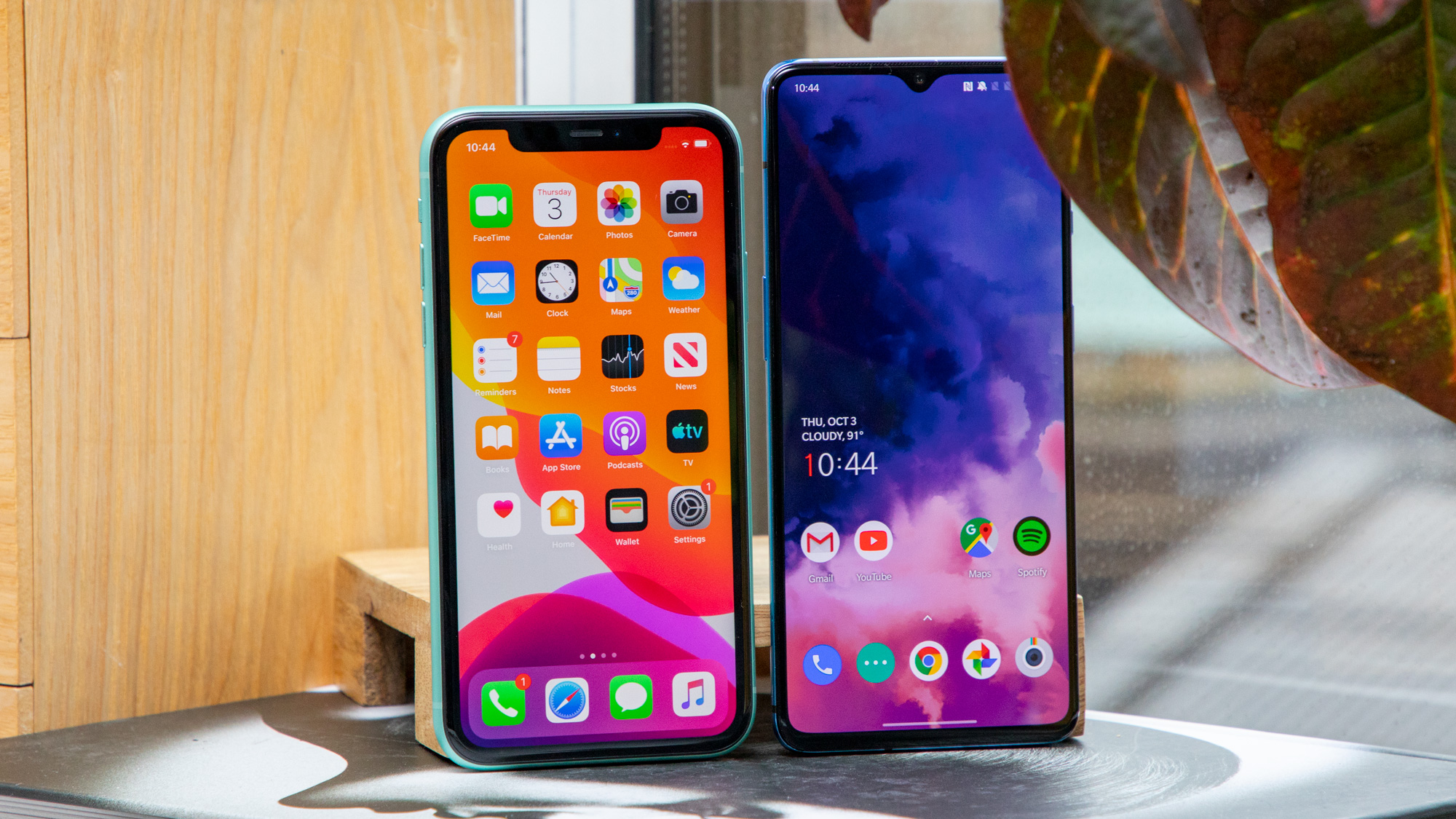
Sure, smartphones cost more than they ever have. But if you know where to look, you'll find some phone makers tirelessly working to bring its best technology down to more affordable prices. Case in point: the $599 OnePlus 7T and Apple's $699 iPhone 11.
Both of those flagship phones retain much of what you get in significantly more expensive devices. They're both powered by top-flight mobile processors, pack multilens cameras and offer meticulously crafted designs that betray their reasonable prices. True, the OnePlus 7T and the iPhone 11 lack luxuries like pop-out selfie cameras, 5G connectivity and ultrahigh resolution displays — but cutting out those niceties keep costs down, and within reach.
So which not-as-pricey-as-it-looks smartphone offers more for what you're spending? Read on to find out how the OnePlus 7T and the iPhone 11 compare.
OnePlus 7T vs. iPhone 11 specs
| Header Cell - Column 0 | OnePlus 7T | iPhone 11 |
|---|---|---|
| Price | $599 | $699, $749, $849 |
| Display | 6.55-inch Fluid AMOLED (2400x1080; 90Hz) | 6.1-inch Liquid Retina LCD (1792x828) |
| Rear Cameras | Triple: 48-MP primary (ƒ/1.6); 16-MP ultrawide (ƒ/2.2); 12-MP telephoto (ƒ/2.2) with 2x optical zoom | Dual: 12-MP primary (ƒ/1.8); 12-MP ultrawide (ƒ/2.4) |
| Front Camera | 16-MP | 12-MP (ƒ/2.2) |
| CPU | Qualcomm Snapdragon 855+ | Apple A13 Bionic |
| RAM | 8GB | 4GB (based on teardown) |
| Storage | 128GB | 64GB, 128GB, 256GB |
| microSD | None | None |
| Battery | 3,800 mAh; 30W fast charging in box | 3,046 mAh (based on teardown); supports 18W fast charging |
| Battery Life (Hrs:Mins) | 8:47 | 11:16 |
| Colors | Frosted Silver, Glacier Blue | Black, Green, Yellow, Purple, White, Red |
| Size | 6.33 x 2.93 x 0.32 inches | 5.9 x 3 x 0.3 inches |
| Weight | 6.7 ounces | 6.84 ounces |
Design
Phones might seem pretty homogenous these days, but the OnePlus 7T and the iPhone 11 buck that trend with radically different designs.
For starters, the OnePlus 7T is taller and narrower, but a hair lighter, while the iPhone 11 is squatter, with slightly thicker bezels all around. The iPhone 11 also incorporates a conventional wide notch, while the OnePlus 7T goes the teardrop route, shoehorning its earpiece in a slit above the selfie camera.
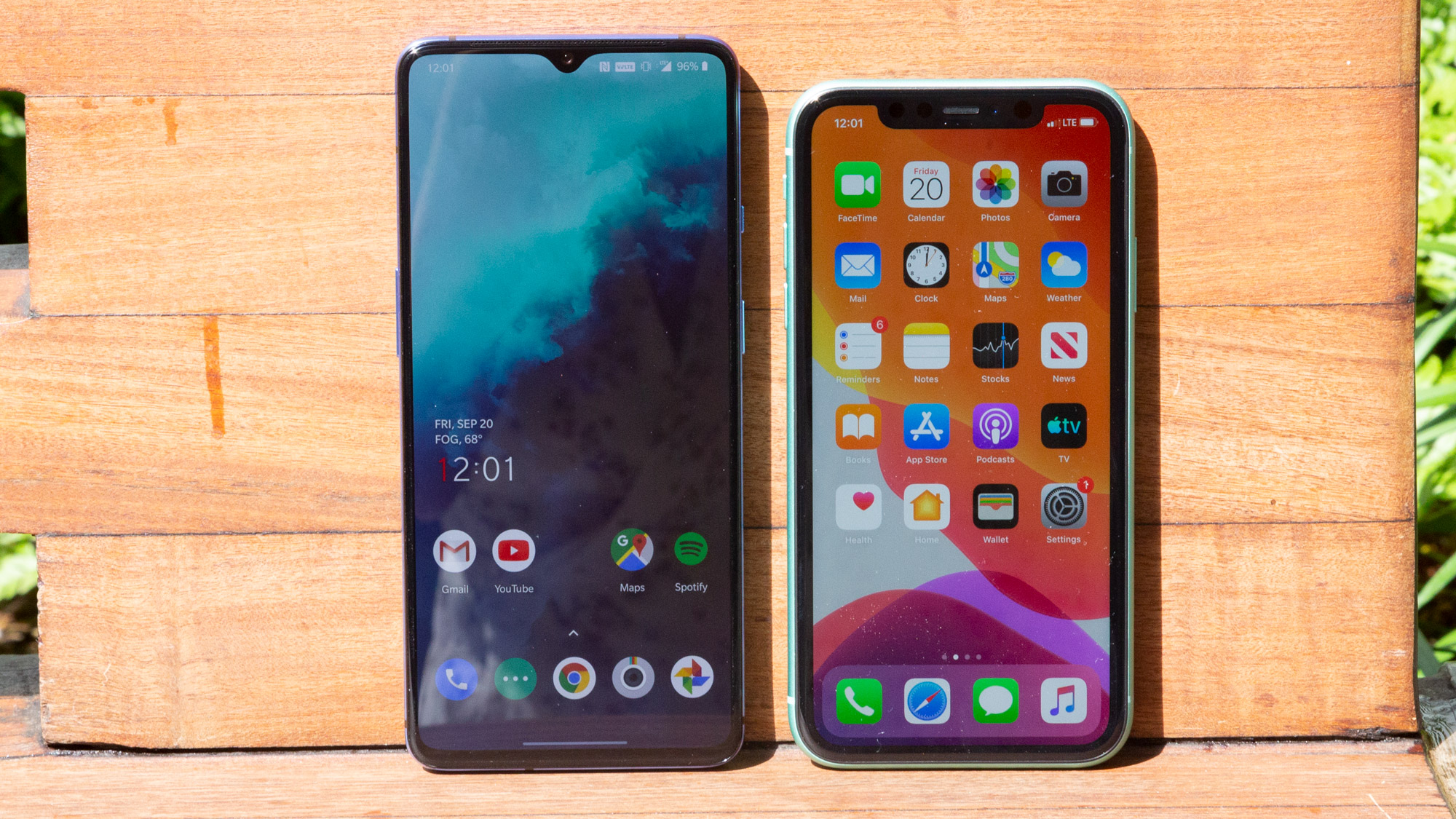
I’m not a particularly huge fan of either device from a usability standpoint — they're both a little too large for me to comfortably use one-handed. That said, the iPhone 11's wider frame makes it more cumbersome in my experience. I also prefer the matte glass finish on the back of the OnePlus 7T, which evokes a more premium feel akin to the similar texture Apple employs on the pricier iPhone 11 Pro and the Pro Max.
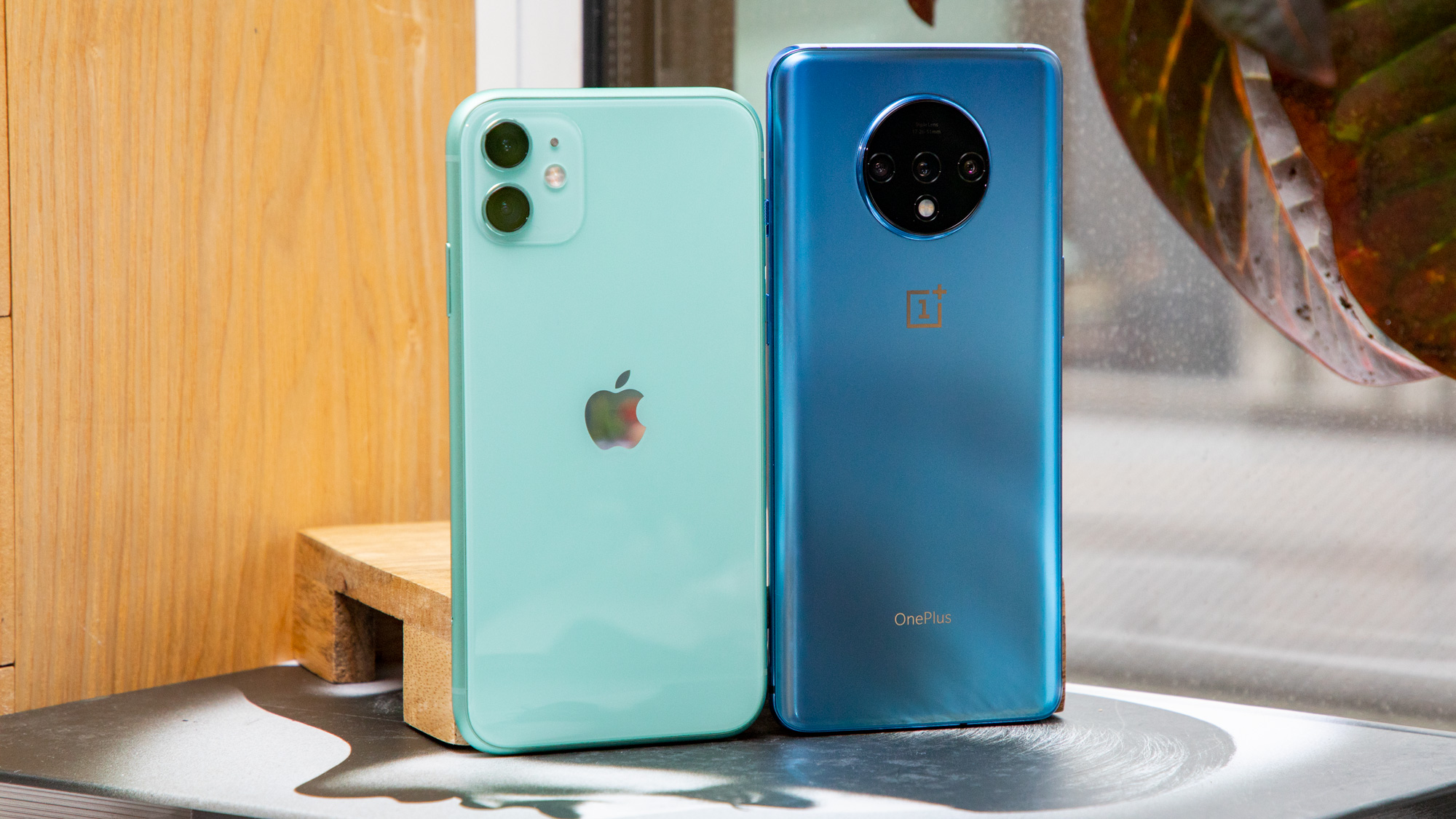
However, if there's one area where Apple definitely comes out on top, it's durability. I trust the iPhone 11's IP68 water-resistance rating (up to 2 meters of water for 30 minutes), whereas OnePlus' reluctance to certify its handsets in similar conditions gives me pause. Also, for what it's worth, the iPhone 11's square dual-camera stack may look awkward at first glance, but it's far less of an eyesore than the circular housing that juts from the back of the OnePlus 7T.
Ultimately, OnePlus' device is still a more bleeding-edge, trimmed-down representation of where mobile design is headed, though the iPhone 11's superior fit and finish definitely wins Apple some favor here.
Winner: OnePlus 7T
Display
Would you rather have an extremely bright screen or one that's dimmer, but produces more captivating colors? That's the choice you're getting from the iPhone 11 and the OnePlus 7T.
Apple's device uses an LCD panel, which means you're not getting the same rich hues and deep blacks offered by more modern OLED displays, like the one in the OnePlus 7T.
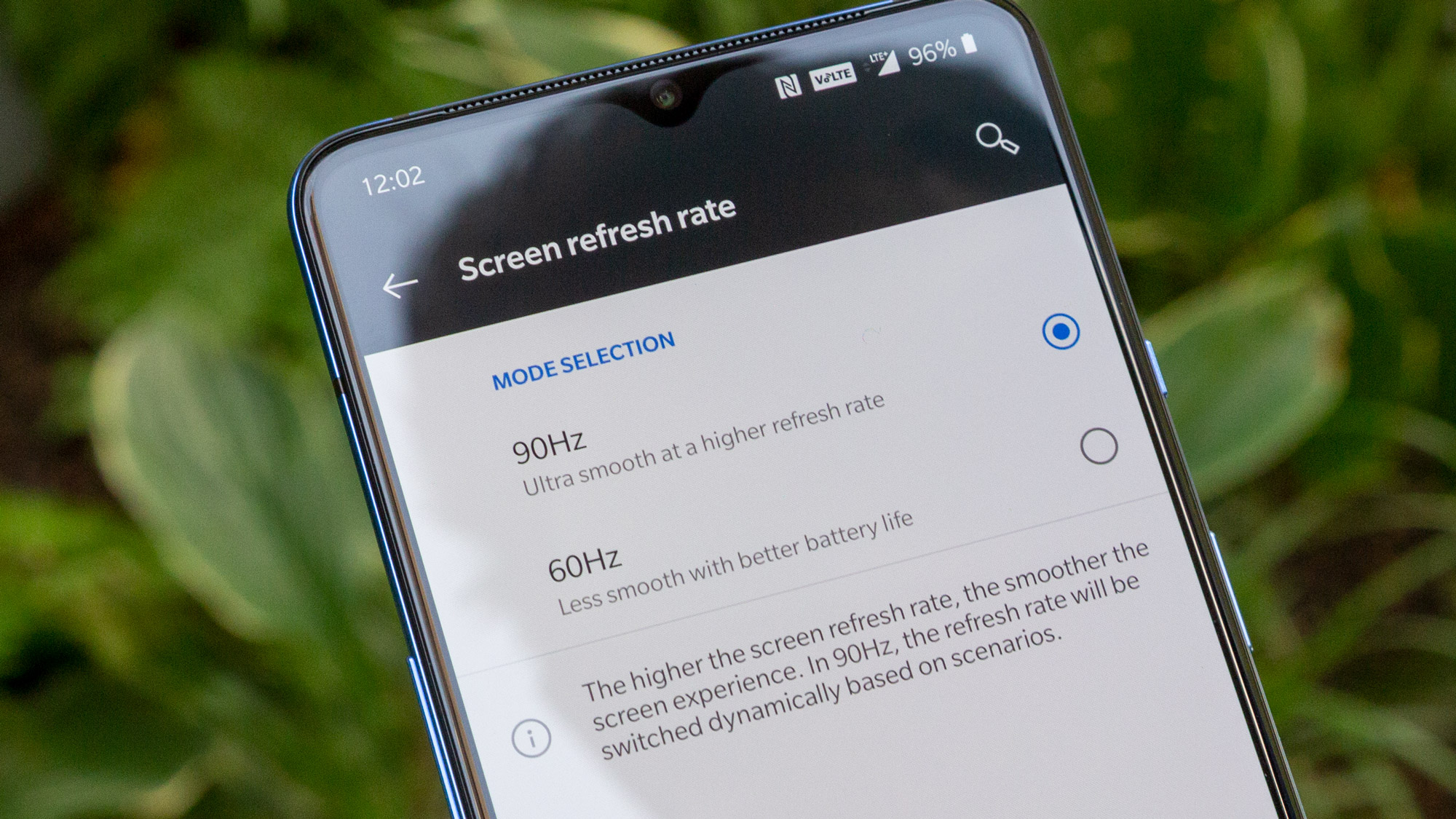
The OnePlus 7T's screen also offers a higher resolution, with a noticeably greater density of pixels (402 pixels per inch, compared with the iPhone 11's 326). More important, it refreshes at a faster 90Hz, making for super-smooth scrolling and animation. The iPhone 11 is capped at 60Hz, like most phones.
At 6.55 inches, the OnePlus 7T's display is technically larger than that of the 6.1-inch iPhone 11 — though the OnePlus' aspect ratio is narrower, so the 7T doesn't feel significantly bigger given the wider proportions of Apple's hardware.
The iPhone 11's 652 nits of peak full-screen brightness make it the phone you'd rather use on a sunny day, compared with the 474-nit OnePlus 7T. That's about the only scenario in which I'd rather have Apple's screen, though. The 7T's 155.1% coverage of the sRGB color space shatters the iPhone 11's 113%, thanks in large part to the power of OLED technology. Add in the 7T's smoother refresh rate and sharper resolution, and the OnePlus easily walks away with victory in the display round.
Winner: OnePlus 7T

Camera
With a trio of sensors on the back, comprising standard wide, ultrawide and telephoto lenses, the OnePlus 7T is pretty versatile as far as smartphone cameras go. But the quality of the photos it captures — even with the help of a 48-megapixel main shooter — can't quite contend with Apple's mastery of computational photography present in the iPhone 11's dual 12-megapixel optics.
That's not to say the OnePlus doesn't draw close. The 7T's 48-MP, ƒ/1.6 aperture primary camera delivered a crisp, clean and refreshing shot of Hudson Yards' Vessel on an unseasonably gorgeous September morning. The iPhone 11, however, painted a more realistic scene, with sharper details, more life-like color, less blown-out highlights and warmer lighting overall that more accurately reflected true conditions.
Both phones produced striking landscapes from the perimeter of Jersey City, looking at the skyline of Lower Manhattan from across the Hudson River. The cast seems a bit off in each case — the OnePlus 7T's take seems too red to my eyes, while the greenish slant of the iPhone 11 doesn't appear correct, either. The iPhone did preserve more of the rocks' texture below, and drew more gradients out of the clouds in the sky, but otherwise there's a lot to like from each handset.
Things do begin to skew a bit in OnePlus' favor, however, once we tried a close up on a building in the distance using zoom on each phone. Of course, the iPhone 11 doesn't have a 2x telephoto lens like the OnePlus 7T does, and its digital zoom couldn't make up for that omission.
In the dark, it's easier to see how Apple's and OnePlus' unique image processing techniques produce wildly different results. While I do like the sense of drama provided by the deeper contrast of the 7T's shot, OnePlus' Nightscape feature lays on the brightening a bit too aggressively around the street level and parked cars. Conversely, the iPhone 11's Night Mode preserves the strength of the highlights against the shadows, and exercises a soft touch in manipulating the tone of the image overall — again producing a more lifelike scene.
If you're more interested in a phone that can take decent photos across a wide breadth of situations — from ultrawide landscapes to optical zoom shots from a distance — the OnePlus 7T might be a better choice. But if you want the best image quality possible under $700, the iPhone 11 is the answer.
Winner: iPhone 11

Performance
The Qualcomm Snapdragon 855+ chipset inside the OnePlus 7T is the most powerful CPU available to Android phones these days. And yet, even with the 7T's 8GB of RAM, it still can't match the blistering pace of Apple's A13 Bionic silicon.
The iPhone 11 notched a 3,251 score in Geekbench 5, a test of overall system performance. The OnePlus 7T topped out at 2,759. The iPhone 11 is also more adept at graphics rendering, as it churned out 1,481 frames at 23 frames per second in GFXBench's Aztec Ruins off-screen test. The OnePlus 7T called it quits after 1,169 frames, at 18 fps.
MORE: Best Phones of 2019
Speedy though the 7T is, it can't outrun the Apple's in-house system-on-chip in benchmarks. That said, you're not likely to experience a discrepancy in performance in most cases. The iPhone 11 may be able to flex its extra muscle in particularly demanding games, but the gap is slim.
Winner: iPhone 11
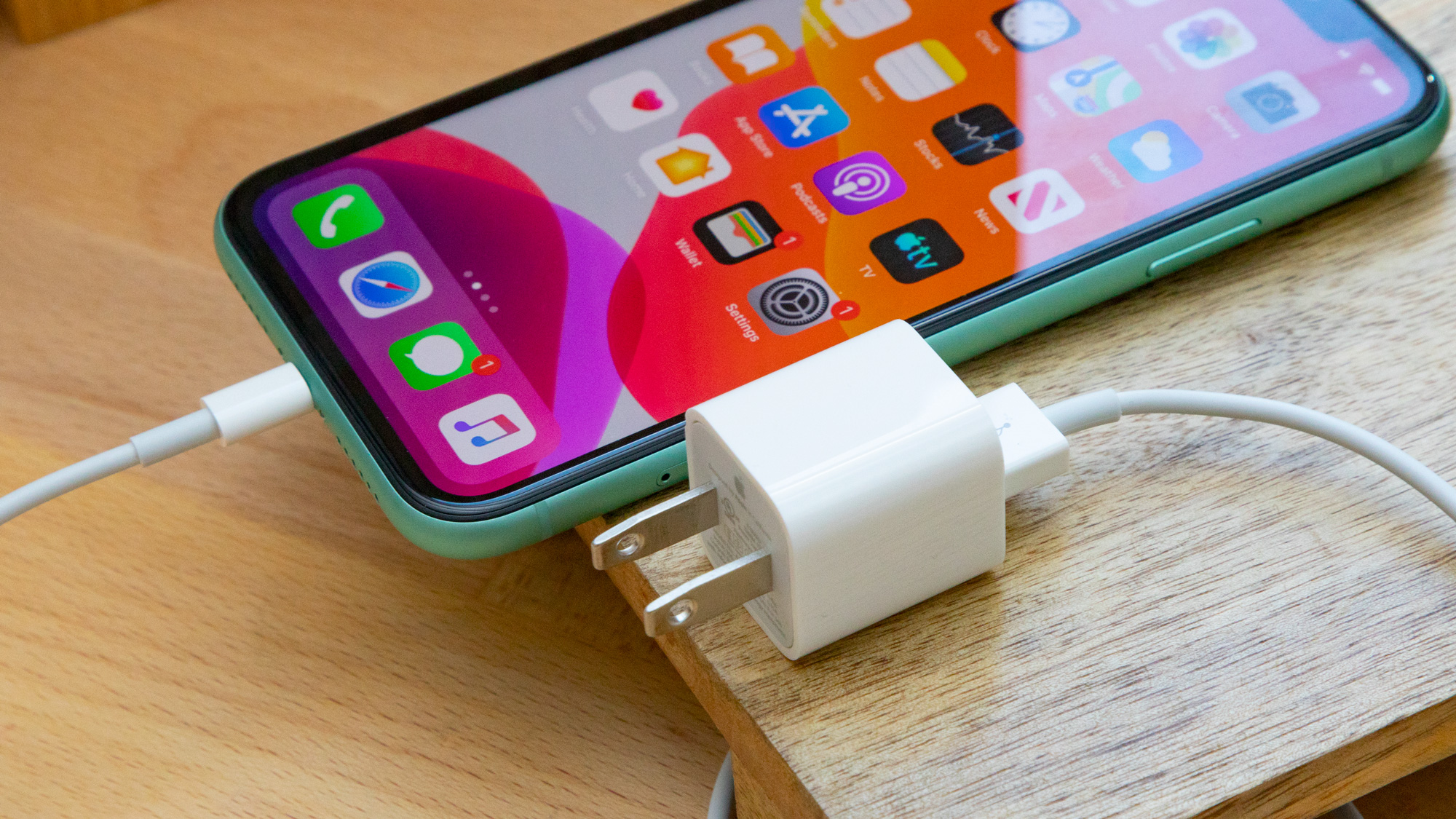
Battery life and charging
The iPhone 11 has a relatively small battery compared with the OnePlus 7T. The 3,046 mAh power pack inside the iPhone 11 is about 20% smaller than the 3,800 mAh unit that powers the OnePlus 7T (at least according to teardowns of Apple's device).
And yet, it's the iPhone that lasted longer on a charge in our testing, holding out for 11 hours and 16 minutes of website streaming over T-Mobile's LTE network before it ran out of juice. The OnePlus 7T topped out at 8 hours and 47 minutes, well below average for a smartphone on our test.
The OnePlus 7T can charge faster out of the box with the adapter that comes with the phone. OnePlus' Warp Charge 30T technology took the device from empty to 61 percent in 30 minutes. The iPhone 11's stock brick certainly can't do that; owners will have to shell out another $50 for Apple's USB Type-C brick and associated cable, which can get the iPhone 11 to 50 percent in a half hour. For what it's worth, the iPhone 11 can also charge wirelessly — something no OnePlus phone to date has supported.
Winner: iPhone 11
Software and special features
It's a tale of two operating systems. The OnePlus 7T runs Android 10, bolstered by OnePlus' own OxygenOS 10.0 front end that adds quite a few features to Google's software. Meanwhile, the iPhone 11 is powered by iOS 13.
The platform you'd rather use likely comes down to personal preference, or which ecosystem you're more invested in.
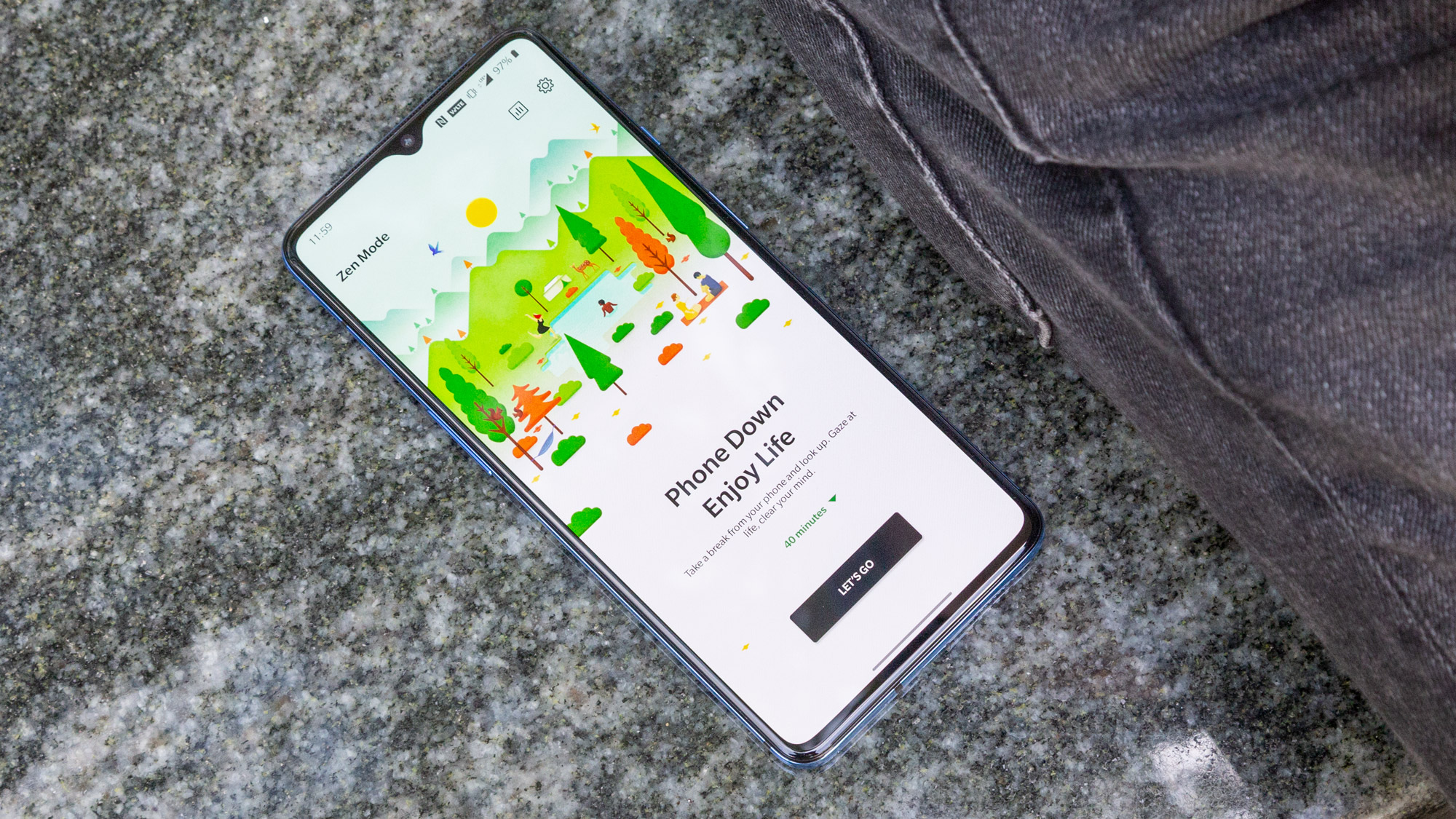
For what it's worth, we think iOS 13 presents a more useful update to Apple's operating system than Android 10 does for Google's. Apple has made sizable updates to the Maps and Photos apps in iOS 13, and introduced a pretty comprehensive Dark Mode we especially like. Meanwhile, Android 10 still feels unfinished, with Google's new Live Caption feature still yet to come, while Google's own dark interface is full of inconsistencies and core apps that don't yet support the new look.
However, OnePlus has refined some of Android 10's rougher edges. We like the 7T's extra nifty features, like the ability to capture scrolling screenshots and OxygenOS' built-in Reading Mode, that subtly dulls colors on-screen to be easier on the eyes.
Regarding security, OnePlus and Apple again have opted for different strategies. The 7T features an optical fingerprint sensor embedded in the display that works pretty well, and is more reliable than the optical scanners of old. The iPhone 11 benefits from Apple's third-generation Face ID technology, which has been refined to near-perfection at this point, and better represents where biometric authentication is headed.
Winner: iPhone 11
Price and availability
At $599, the OnePlus 7T slides in at $100 less than the cheapest iPhone 11, which costs $699 for a 64GB model. You'll need to spend $749 to get yourself an iPhone 11 with the same 128GB of storage offered in the OnePlus 7T. The 256GB variant of the iPhone 11 costs $849, and OnePlus doesn't sell a higher capacity version of its device. Neither handset offers expandable storage with microSD memory cards, so you're stuck with the capacity you're given.
The iPhone 11 comes unlocked for all wireless networks, GSM and CDMA alike, and is sold through virtually every carrier under the sun. You can also buy the OnePlus 7T unlocked, though it is only wired to fully support GSM networks, like AT&T and T-Mobile. The 7T can work on Verizon with a bit of elbow grease, but even then you can't walk into your carrier of choice and just buy one — unless that carrier happens to be T-Mobile, which does carry the OnePlus 7T.
The OnePlus 7T ultimately gets the nod for its near-bargain price, though OnePlus' lack of wider availability makes this a closer call than it would otherwise be.
Winner: OnePlus 7T
Overall winner: iPhone 11
The OnePlus 7T is a phenomenal value, and if you're an Android devotee, it's definitely the phone you should walk away with, without a second thought. However, the iPhone 11 is just a little more well-rounded.
| Header Cell - Column 0 | OnePlus 7T | iPhone 11 |
|---|---|---|
| Design (10) | 8 | 7 |
| Display (10) | 9 | 7 |
| Camera (25) | 19 | 22 |
| Performance (15) | 13 | 14 |
| Battery (20) | 15 | 17 |
| Software (10) | 9 | 10 |
| Price and availability (10) | 9 | 7 |
| Total (100) | 82 | 84 |
Apple's cameras are more consistent, its software is more refined, its battery lasts considerably longer on a charge and iPhone users get unbeatable performance. Ultimately, the iPhone 11 is a little let down only by its dated-yet-bright LCD display and comparatively high price, though if you can see past those shortcomings, it's the better handset overall.
Sign up to get the BEST of Tom's Guide direct to your inbox.
Get instant access to breaking news, the hottest reviews, great deals and helpful tips.
Adam Ismail is a staff writer at Jalopnik and previously worked on Tom's Guide covering smartphones, car tech and gaming. His love for all things mobile began with the original Motorola Droid; since then he’s owned a variety of Android and iOS-powered handsets, refusing to stay loyal to one platform. His work has also appeared on Digital Trends and GTPlanet. When he’s not fiddling with the latest devices, he’s at an indie pop show, recording a podcast or playing Sega Dreamcast.
